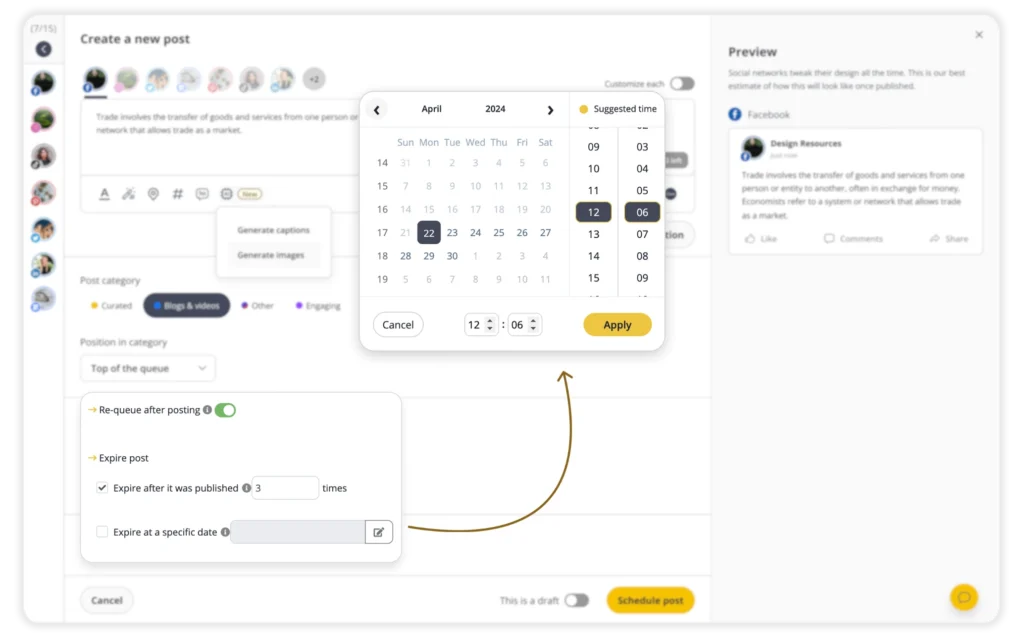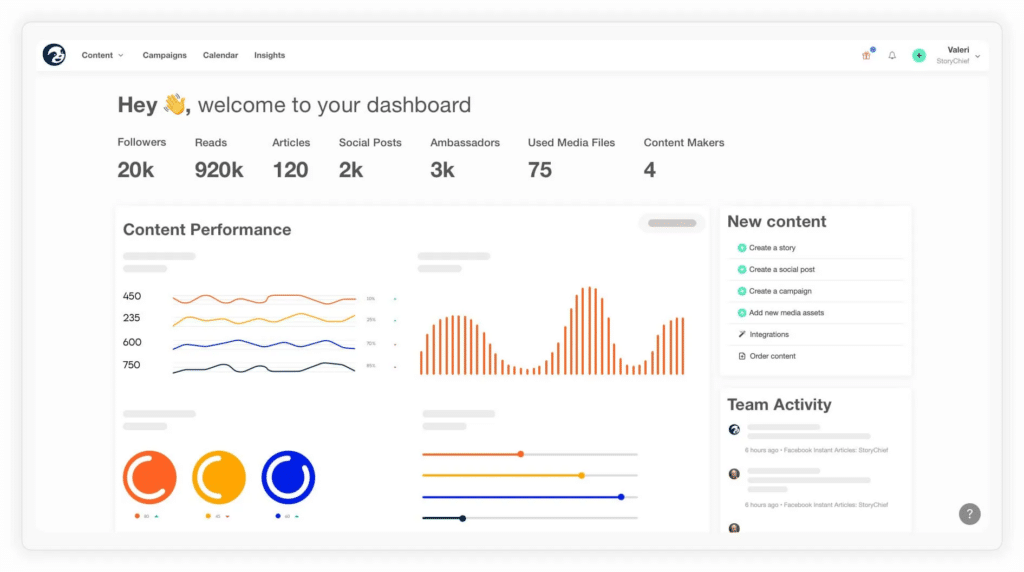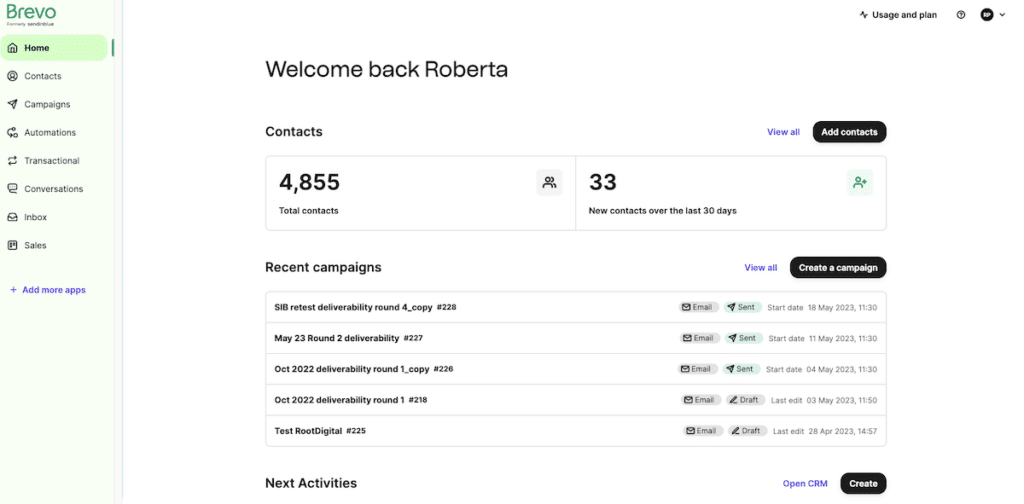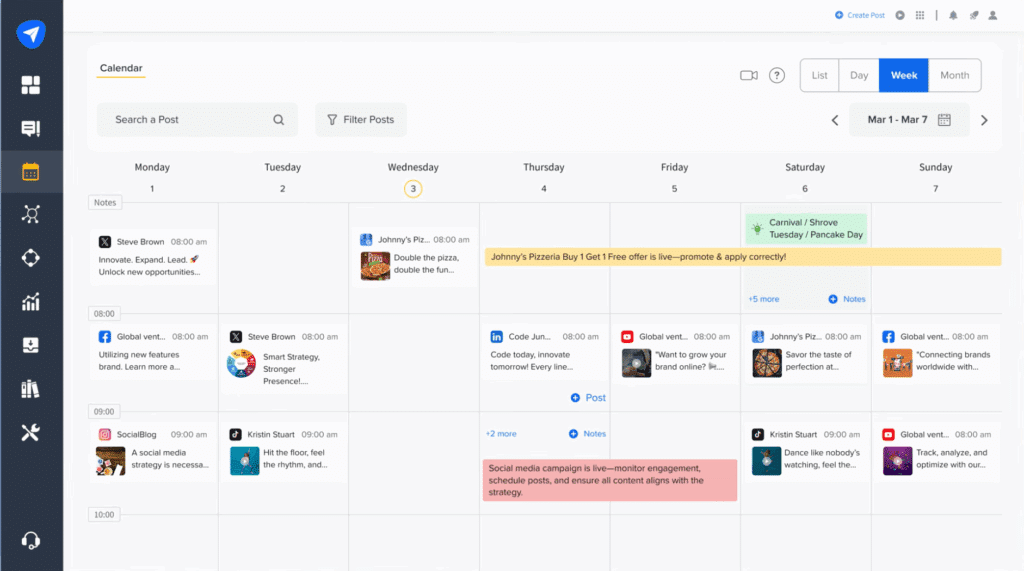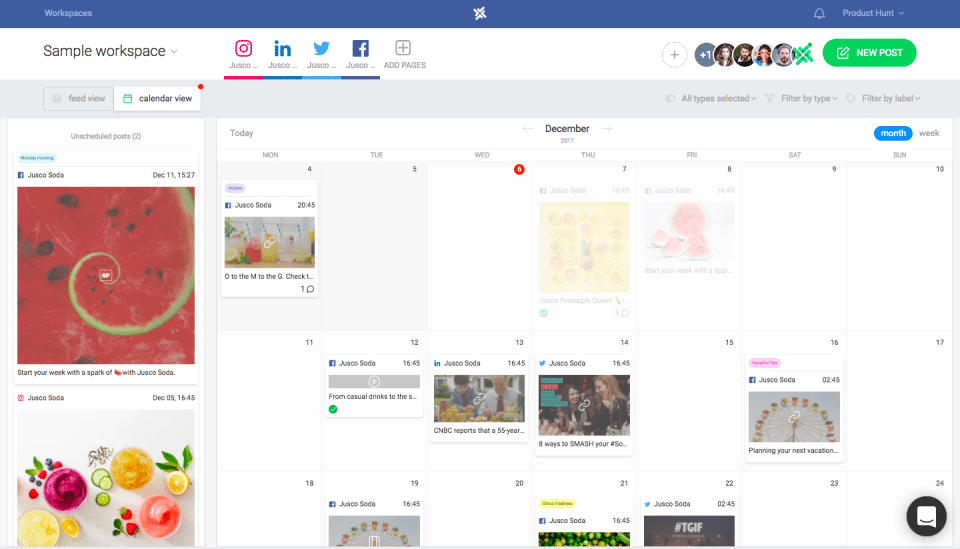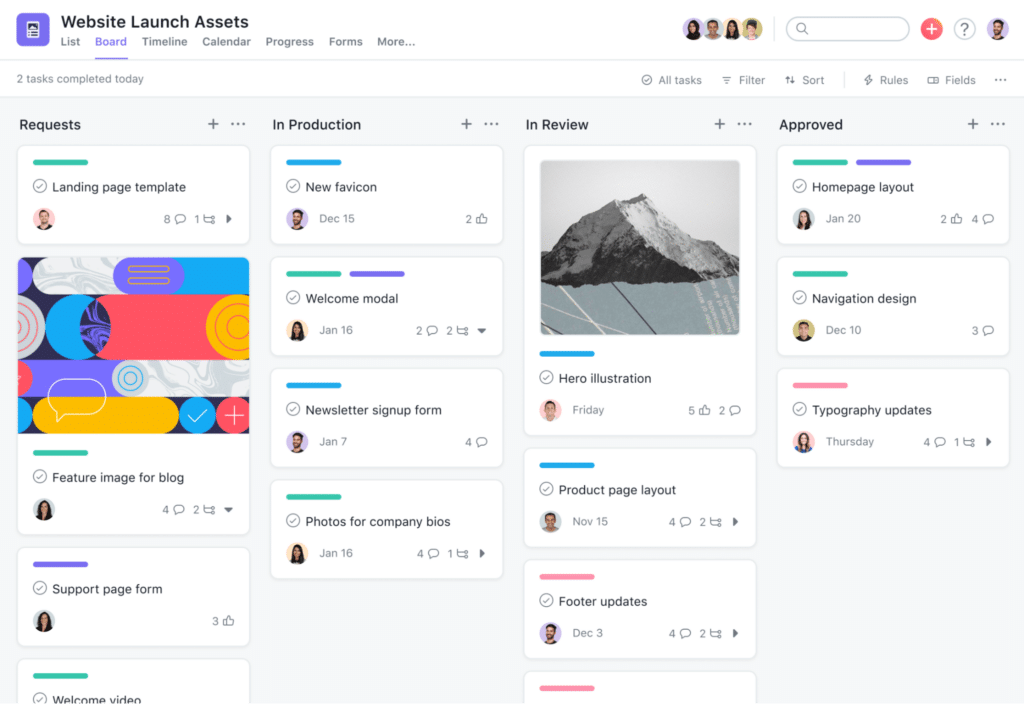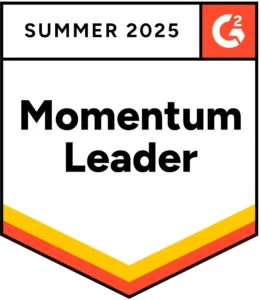
Content Writer at SocialBee
To stay organized and on top of everything, many people turn to content calendar tools. Without them, it’s easy to get overwhelmed when you’re trying to keep up with blogs, social media, email campaigns, and everything in between.
In this article, we’ll explore five content calendar tools that can streamline your workflow and help you manage your content more efficiently. From scheduling posts to team collaboration, these tools offer various features to suit different needs, whether you’re new to content management or have been at it for a while.
By the end, you’ll have a clearer sense of which tool aligns with your specific goals—whether it’s simplifying repetitive tasks or just staying organized.
Plan your posts in no time with hundreds of post ideas and Canva templates.
We’re SocialBee LABS SRL, part of WebPros. We use the information you provide to share relevant content and product updates, as outlined in our Privacy Policy. You can opt out anytime.
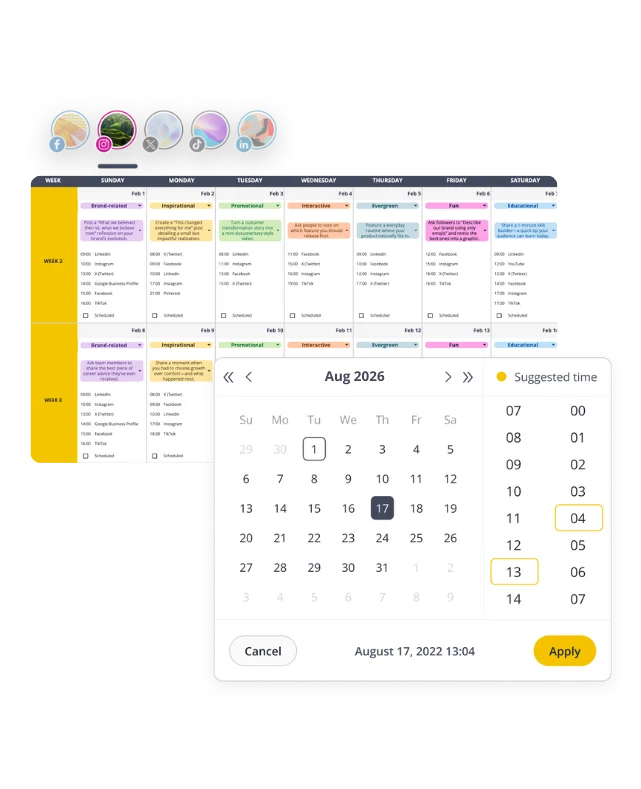
Short Summary
- SocialBee: Best for managing your social media planning, this tool allows you to organize content into categories (folders), schedule posts, recycle them, and generate content with AI. Pricing starts at $29/month.
- StoryChief: Best for sharing content across multiple platforms including social media accounts and blogs. Pricing starts at $40/month.
- HubSpot Social Media Management: Best for enterprise-level companies. Create, publish, and measure multi-channel content performance, as well as monitor brand mentions through AI-powered insights. Pricing starts at $800/month, with 3 users included.
- Brevo: Best content calendar for managing email and SMS marketing campaigns. Streamline your outreach and improve communication workflows. Pricing starts at $9/month.
- SocialPilot: Best for teams and agencies. Create, publish and analyze your content with real-time feedback and insights from your team. Pricing starts at $30/month.
- Planable: Best collaborative tool for approving your team’s content in real-time. Assign tasks, review posts, and ensure seamless teamwork. Pricing starts at $11/user per month.
- Asana: Best for organizing your content calendar while managing projects and tracking tasks. Plan campaigns and keep your team aligned. Pricing starts at $10.99/month per user.
What to look for in the best content calendar?
When choosing a content calendar, find a tool that supports all the platforms and types of content you plan to publish. Good software should streamline teamwork with features that simplify content approval and feedback. It should also include analytics to monitor how your content is performing.
Here are the key features of a content calendar:
- Ease of content creation: A great content calendar should make creating and organizing content painless. It should give you a clear, visual workspace where you can easily drag and drop posts, plus a built-in media library for storing all your images and videos. The best tools also let you draft and edit right in the calendar, saving you from endless email threads and helping you keep everything on track.
- Cross-platform scheduling: Managing content across multiple platforms can be overwhelming. A good content calendar lets you plan, schedule, and post to all platforms from one spot. It should also allow you to tweak posts for each platform and automate recurring or seasonal content, so you’re not constantly doing it manually.
- Collaboration and team management: If you work with a team, you’ll want a content calendar that makes collaboration easy. Look for one that lets you assign roles, set deadlines, and give feedback in real-time. This way, everyone knows what they need to do, and things move smoothly without confusion or missed deadlines.
- Analytics and reporting: Posting content is only half the battle—you need to know what’s working. A solid content calendar comes with built-in analytics so you can track how your content is performing. You should be able to pull reports to see what’s driving engagement or traffic, helping you make smarter decisions moving forward.
- Integration with other tools: Your content calendar should work with the other tools you’re already using, like social media schedulers, email platforms, and design apps. This keeps everything connected, making it easier to manage your content and ensuring it aligns with your overall marketing goals.
🎥 Watch: Plan a YEAR of Social Media Posts in Just MINUTES!
Before you find the best content calendar for your needs, watch this short video to learn how to plan a full year of content in just a few minutes.
You’ll also pick up a handy Canva trick to instantly turn your list of ideas into dozens of ready-to-go designs, saving you tons of time and effort.
Best content calendars to use
To effectively manage your social media strategy and ensure your content is consistently scheduled and shared across platforms, having the right tools in place is essential.
Whether you’re managing multiple accounts, collaborating with a team, or simply looking to save time, these social media content calendars offer features that can help streamline your workflow and boost productivity.
Here are the best content calendars:
- SocialBee: Best for managing social media planning.
- StoryChief: Best for publishing across multiple platforms with integrated SEO tools.
- HubSpot Social Media Management: Best for managing social campaigns at scale, tracking analytics, and monitoring brand mentions.
- Brevo: Best content calendar for managing email and SMS marketing campaigns.
- SocialPilot: Best for teams and agencies.
- Planable: Best collaborative tool for approving your team’s content in real time.
- Asana: Best for organizing your content calendar while managing projects and tracking tasks.
1. SocialBee
SocialBee is a top-rated social media content calendar tool designed to simplify social media management for small businesses, entrepreneurs, and marketers. It allows users to effortlessly create, organize, and schedule content across multiple platforms, making it an essential tool for running all your social media campaigns.
With SocialBee, you can plan your posts in advance, analyze content performance, and manage social media comments, mentions and DMs, all from one intuitive user interface.
Many users appreciate how SocialBee takes the hassle out of managing multiple social media accounts. For instance, one of our users shares, “SocialBee helps me organize content by themes and categories, which makes way more sense to me than organizing by date. I can quickly and clearly see what types of content by category/theme are getting posted and how often. If I want to change the calendar to focus on different content types I can easily do it in a few clicks.” This highlights SocialBee’s ability to streamline social media tasks, saving users time and effort.
Besides content categorization, SocialBee stands out with its post resharing features.
You can easily recycle and automatically repost evergreen content to keep your social media active, even on slower days. This helps maintain a consistent content flow without scrambling for new ideas. By focusing on content recycling and resharing, SocialBee ensures your audience stays engaged while saving you time and effort.
Key SocialBee features:
- Supported social platforms: Manage posts across Facebook, X (formerly Twitter), LinkedIn, Instagram, TikTok, Pinterest, Google Business Profile, YouTube, and Bluesky. SocialBee also allows posting on non-integrated platforms like Facebook Groups, Reddit, WhatsApp, Telegram, Mastodon, and Quora, ensuring you can share content on any platform, even those without direct integration.
- Universal posting: Schedule and share content seamlessly across multiple platforms, keeping your workflow efficient and streamlined.
- Visual integrations: Curate and import visuals from Canva, Unsplash, and GIPHY directly from SocialBee.
- AI tools: Automatically generate captions and visuals for your posts, and receive personalized recommendations for optimizing your content strategy, such as improving engagement, timing, or post design.
- Best posting times: SocialBee analyzes your past performance to suggest customized recommendations for optimal posting times.
- Platform-specific customization: Tailor your posts for each platform’s unique style or use AI for automated adjustments.
- RSS feed integration: Import content from your favorite blogs to keep your calendar updated with fresh posts.
- Team collaboration: Assign roles, provide feedback, and manage post approvals, making team workflows smoother.
- In-depth analytics: Track performance and generate detailed PDF reports to refine your strategy.
- Social inbox: Manage comments, mentions, and DMs in real-time, ensuring engagement with your audience.
Best for: SocialBee is a social media calendar ideal for startups and small businesses needing an all-in-one social media scheduling tool with AI features for content planning, design, and performance tracking.
Unique feature: SocialBee’s Universal Posting feature allows you to schedule content for platforms that aren’t directly integrated, ensuring comprehensive social media coverage.
Pros:
- Affordable and flexible pricing plans
- Comprehensive social media management features
- Responsive customer support with regular updates
- Users can suggest and vote on new features
Cons:
- Slight learning curve at the beginning
- No hashtag analytics
- No link-in-bio tools
G2 rating:
4.8/5 stars (based on 429 reviews)
Pricing:
Starts at $29/month
Free trial:
Yes, SocialBee offers a 14-day free trial.
Essential features checklist:
✅ Multi-platform integrations
✅ Content creation and editing (text and visual)
✅ AI content generation
✅ Content curation tools
✅ Visual content calendar
✅ Post scheduling and publishing
✅ Team collaboration and management
✅ Social inbox
✅ Social listening
✅ Social analytics and reporting
❌ Multi-language support
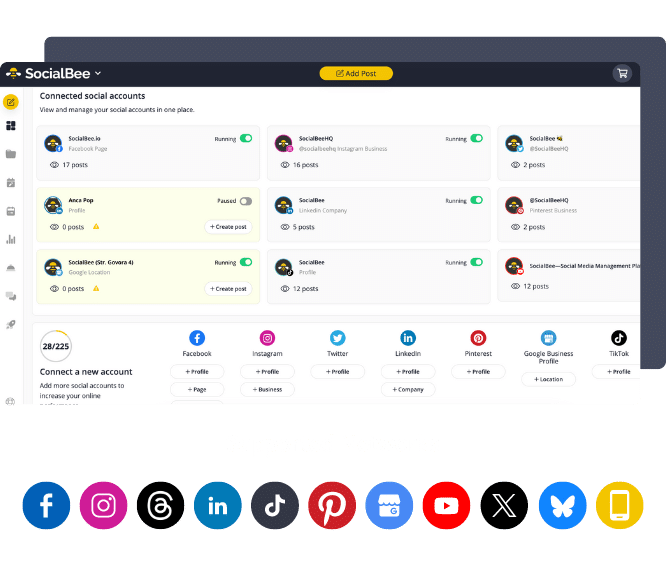
2. StoryChief
StoryChief is a content calendar platform designed to help teams and agencies streamline content creation and sharing. With StoryChief, users can draft, optimize, and publish content across multiple channels like blogs, social media, and newsletters simultaneously, making it a great tool for content creators looking to manage all their campaigns in one place.
Its clean, intuitive interface allows teams to collaborate in real-time, making it easier to get feedback and approvals before content goes live.
StoryChief’s ability to handle multichannel distribution sets it apart from other tools. Teams can manage everything from blogs to social posts without switching between platforms.
At the same time, StoryChief’s built-in search engine optimization (SEO) tools help ensure that every piece of content is optimized for search engines. These tools are designed to help more people find your content online. They do this by helping you choose effective keywords, analyzing how easy your content is to read, and providing a score to indicate how well your content is optimized for search engines.
It’s also equipped with an analytics feature to track the success of each campaign across all channels.
Key features of StoryChief:
- Multi-channel content publishing: Distribute your content to blogs, social media, and newsletters simultaneously, while also planning and organizing content campaigns across multiple platforms using a built-in content calendar.
- SEO tools: Optimize content for search engines directly within the platform.
- Real-time team collaboration: Work with your team to draft, edit, and approve content efficiently.
- Mobile access: Manage and edit your content from mobile devices.
- Performance tracking: Monitor the reach and engagement of your content with built-in analytics.
Best for: StoryChief is ideal for content teams, marketers, and agencies who need a single platform to manage content creation, distribution, and performance across various channels.
Unique feature: StoryChief’s built-in SEO tools are designed to optimize content directly within the platform, offering real-time readability analysis, keyword suggestions, and SEO scoring. This ensures that every piece of content is fully optimized for search engines before it’s even published, eliminating the need for additional SEO tools and streamlining the entire content creation process.
Pros:
- Simplifies multi-channel publishing
- Built-in SEO optimization tools – “We especially like the built-in SEO guidance, readability analysis, and the fact that we can trickle-publish and syndicate our content to multiple channels over several weeks.” says Juergen, co-founder and creative directors.
- Effective for team collaboration and content approvals
- Clear content calendar for planning campaigns
Cons:
- Higher price point for smaller teams
- Limited advanced analytics features
- No built-in social listening tools
- Lacks extensive integrations – “I’m hoping StoryChief has the ability of a Chrome extension or Firefox plugin to generate posts quickly.” says Michael.
- No A/B testing for content
G2 rating:
4.5/5 stars (based on 30 reviews)
Pricing:
Starts at $40/month.
Free trial:
Yes, StoryChief offers a free trial to explore its features.
Essential features checklist:
✅ Multi-channel publishing
✅ SEO optimization
✅ Real-time collaboration and editing
✅ Mobile access
✅ Content calendar
✅ Performance tracking
✅ Integration with WordPress and Medium
❌ No social listening tools
❌ No A/B testing
❌ Limited CRM integrations
❌ No advanced link tracking
3. HubSpot Social Media Management
HubSpot’s social media management solution includes a broad AI feature set designed to help larger teams boost productivity and social engagement across multiple networks.
The platform includes dedicated social post generators, while its ideal posting time suggestions use historical social account performance to spot the best time slots to publish content for maximized audience engagement. HubSpot also lets you connect social media accounts with your blog. That means you can automatically share blog posts to your socials once they’re published.
Social listening tools are another standout here. You can set up keyword monitoring streams, and the platform pulls in all comments and brand mentions that include your set keywords. You can then use HubSpot’s native CRM integration to link interactions to your database and see extra info about particular user accounts or whether you previously interacted with said users.
Linking the social media management tool with your CRM also means you get to see exactly how many leads, site visits, or customers your social campaigns generate.
Key features of HubSpot Social Media Management:
- AI features: Use the platform’s AI assistants to create social posts from scratch, get ideal posting time suggestions, and generate weekly social performance summaries covering engagement, high-performing content types, and so on.
- Cross-channel reporting: Measure social media performance alongside website and email marketing metrics to get a 360-degree overview of your content marketing efforts.
- Social media monitoring: Monitor and reply to brand mentions, use the platform’s CRM to get extra context behind each social account.
- Email alerts: Set up email alerts to get notified about comments containing particular keywords.
- Extra marketing tools: Access extra features like email marketing, site and form builders, and SEO tools via the Marketing Hub.
Best for: HubSpot’s social media management solution is ideal for enterprise-level companies looking to boost their social media efforts through powerful AI tools and reporting features, as well as measure their social marketing strategy’s impact on their overall content marketing efforts.
Unique feature: The social media management solution is part of HubSpot’s Marketing Hub. You get access to dozens of other marketing-specific features covering channels beyond social media.
Pros:
- Unified analytics – “Loved how the marketing lead database is able to combine and centralize our marketing assets like leads, contact information, and website visit history that is captured by social media campaign and email marketing campaign into one storage.” says David H.
- Solid AI toolset designed to automate routine tasks and boost engagement
- The native CRM integration gives contextual details around user accounts
- Social listening tools included
- Efficient scheduling tools
Cons:
- The social media management solution is only available in Marketing Hub’s top-tier pricing plans
- You cannot use HubSpot’s social media management tools as a standalone solution – a Marketing Hub subscription is required
Pricing:
Starts at $800/month with 3 users included
Free trial:
No
Essential features checklist:
✅ Email marketing
✅ SMS marketing tools
✅ Landing page creation
✅ CRM integration
✅ Web page hosting
✅ Marketing automation
✅ Segmentation tools
✅ Social media management
✅ Multi-channel analytics
❌ Limited collaboration tools
❌ Limited social network support
4. Brevo
Brevo (formerly known as Sendinblue) is a versatile platform that offers a wide range of tools to help businesses manage their marketing and communication efforts.
Originally known for its email marketing capabilities, Brevo has evolved into a comprehensive marketing solution that includes email marketing, SMS software, CRM tools, and more. It’s designed for small to medium-sized businesses looking to streamline their communication, whether through email, SMS, or web marketing.
Brevo is especially useful for businesses running online stores or websites, as it allows them to store content, design web pages, and set up landing pages for various marketing campaigns.
Its reliable SMS tools make it easy to send targeted messages, promotions, and updates to customers, ensuring you’re reaching your audience wherever they are. Brevo integrates with various platforms, making it a great fit for any online business looking to manage customer engagement in one place.
Key features of Brevo:
- Email marketing: Create and send beautiful, targeted email campaigns.
- SMS software: Send reliable SMS messages to engage with your customers directly on their phones.
- CRM integration: Manage customer relationships and track interactions within the platform.
- Web pages: Design and host simple web pages for promotions or standalone marketing efforts.
- Marketing automation: Set up automated workflows to streamline your marketing efforts.
- Segmentation: Target specific customer groups for more personalized marketing.
Best for: Brevo is perfect for small to medium-sized online businesses and eCommerce stores looking for a reliable platform to manage email campaigns, SMS marketing, and customer relationships, all while building landing pages and web pages for their marketing efforts.
Unique feature: Brevo’s combination of SMS software and email marketing tools provides a well-rounded solution for businesses looking to reach their audience through multiple channels, offering reliable SMS communication along with email marketing campaigns.
Pros:
- Easy-to-use email marketing and SMS tools -”I love the ease of use, it’s very user friendly. I create campaigns and add lists of contacts I want to reach out to. There is a wide variety of easily customizable templates to make my emails look very sharp and professional.” says Megan.
- Great for building and hosting landing pages
- Segment your audience based on behavior, demographics, or engagement levels, and set up automated workflows like follow-ups, welcome sequences, or transactional emails
- Affordable plans for small businesses
- Solid CRM integration for managing customer data
Cons:
- Limited design customization for web pages
- Lacks social media management tools
- No advanced eCommerce-specific features
- Reporting can be basic for more in-depth analytics – “I would love to see the reporting to be more complete and AI integrated with insights.” says Julio.
G2 rating:
4.5/5 stars (out of 2036 reviews)
Pricing:
Starts at $9/month for the paid plans.
Free trial:
Yes, Brevo offers a free plan with limited features and a free trial for premium options.
Essential features checklist:
✅ Email marketing
✅ SMS marketing tools
✅ Landing page creation
✅ CRM integration
✅ Web page hosting
✅ Marketing automation
✅ Segmentation tools
❌ No social media management
❌ Limited design options for web pages
❌ No advanced eCommerce tools
❌ Basic reporting analytics
5. SocialPilot
SocialPilot is a robust social media content calendar and scheduling tool built for professionals, marketing teams, and agencies. With an intuitive interface and powerful calendar view, it allows users to plan, schedule, and publish content across multiple platforms, including Facebook, Instagram, X (Twitter), LinkedIn, Pinterest, TikTok, Google Business Profile, YouTube, Bluesky, and Threads.
The drag-and-drop calendar offers a visual layout to map out posts weeks in advance, with easy rescheduling and filtering options by account or team member. This makes content planning and approvals faster and more organized.
AI capabilities set SocialPilot apart. AI Pilot’s features help customize content for each platform—you can tailor captions, images, and hashtags in a single workflow. AI-powered Best Time to Post feature analyzes your audience engagement data and recommends optimal posting windows for each platform.
It has the world’s first AI scheduler with ChatGPT, you can directly generate ideas, posts, and schedule them from GPT. Its bulk scheduling option also allows uploading up to 500 posts at once via CSV, making it a go-to for teams managing high volumes of content.
Teams can collaborate using roles and permissions, add notes to posts, and use the approval workflow to ensure content meets brand standards before publishing. The tool also supports carousel posts, TikTok scheduling, and access to a content library to manage media files and create evergreen content.
Key features of SocialPilot:
- Multi-platform Publishing: Schedule and customize posts for each platform with a unified calendar view.
- Bulk Scheduling: Upload hundreds of posts at once via CSV or content library.
- AI ChatGPT Scheduler: Auto-generate engaging captions and schedule them instantly using ChatGPT.
- Custom Team Workflows: Assign roles, add post notes, and get approvals from internal or client teams.
- AI-powered Content Assistant: Generate captions and hashtag suggestions using built-in AI tools.
- Visual Intuitive Calendar: Get a bird’s-eye view of all scheduled content and quickly identify gaps or overlaps.
- Content Library: Organize and reuse evergreen content easily across campaigns.
- Analytics & Reporting: Monitor post performance, track audience growth, and export reports for clients or internal review.
- Chrome Extension: Share and schedule content directly from the web with one click.
- Mobile Access: Plan, edit, and approve content on the go using the mobile app.
Best for:
Marketing teams, social media managers, and agencies handling content for multiple brands or clients need a reliable, collaborative, and scalable content calendar.
Unique feature:
SocialPilot’s advanced calendar not only lets you visualize your entire posting schedule but also includes notes and post status filters (scheduled, pending approval, failed, etc.), making it easier to manage content lifecycle and keep everything on track.
Pros:
- Easy-to-use drag-and-drop calendar – “It makes managing multiple social media accounts seamless, especially with its drag-and-drop calendar and bulk scheduling feature. I have also appreciated the detailed analytics and reporting tools, which help track performance and optimize content and are easy to access for the teams.” says Charles A., a marketing manager.
- Supports platform-specific customization and carousel posts
- Strong collaboration features and approval workflow
- AI tools for faster caption and hashtag creation
- Affordable pricing with high publishing limits – “We especially like how easy it is to organize content in the calendar and get client approvals quickly. It keeps our entire agency in sync,” says Rayna, a social media strategist.
Cons:
- The Social Listening feature is missing.
- No direct integration with blogs or newsletters.
- It does not have a competitor analysis feature.
G2 rating:
4.5/5 stars (based on 834+ reviews)
Pricing:
Starts at $30/month (for 1 user and 7 social accounts)
Free trial:
Yes, a 14-day free trial is available. No credit card required.
Essential features checklist:
✅ Multi-platform publishing
✅ AI-powered captions and hashtags
✅ Real-time collaboration and approvals
✅ Mobile app access & Crome extension
✅ Drag-and-drop calendar
✅ Bulk scheduling
✅ Content library
✅ TikTok and carousel post support
❌ No built-in blog publishing
❌ Social listening
❌ Competitor analysis
❌ No direct newsletter integration
6. Planable
Planable is a content management tool designed specifically for social media teams, allowing them to streamline the entire content planning and approval process. With its collaborative features and user-friendly content editor, Planable helps teams easily schedule, preview, and approve posts across multiple platforms.
The tool’s focus on providing a seamless content workflow makes it an excellent solution for social media managers, marketers, and even web developers managing social media alongside other digital projects.
One of Planable’s greatest strengths is its ability to work smoothly across both desktop and mobile devices, ensuring you can plan and approve content anytime, anywhere.
In addition to its sleek design, Planable also simplifies managing digital assets, letting users organize media files, graphics, and other assets all in one place. The ability to collaborate in real-time within the platform allows teams to easily provide feedback and streamline the content creation process, avoiding delays in approvals or edits.
Key features of Planable:
- Collaborative content editor: Edit and review posts in real-time with your team before they go live.
- Cross-platform scheduling: Plan posts for multiple social media platforms in one place, ensuring consistency.
- Mobile access: Manage and approve content from your mobile devices, making it convenient to stay on top of your social media strategy.
- Digital asset management: Store, organize, and access media assets like images, videos, and documents directly within the platform.
- Approval workflows: Collaborate and streamline content approval with your team, allowing for quick reviews and revisions.
- Content calendar view: Easily visualize all upcoming posts and campaigns for better planning.
Best for: Planable is best suited for social media teams, marketers, and web developers looking for a collaborative tool that streamlines content scheduling and approval workflows. Its mobile device support makes it ideal for teams who need to stay flexible while managing content on the go.
Unique feature: Planable’s content editor allows real-time collaboration, letting teams draft, edit, and approve posts simultaneously to speed up the content creation process.
Pros:
- Real-time collaboration and content approval – “Planable is easy to implement and has become an essential part of my day-to-day tasks as a business owner and social media manager. I like how easy it is to plan posts across different social media platforms like Instagram and Pinterest. It’s great that you can connect multiple accounts, which makes managing everything in one place really convenient.” says Bibiana O.
- Mobile-friendly for managing posts on the go
- Easy-to-use interface with a drag-and-drop content calendar
- Efficient for teams managing multiple social platforms
- Built-in digital asset management for organizing content resources
Cons:
- Limited integrations compared to other platforms
- Advanced analytics and reporting require higher-tier plans
G2 rating:
4.6/5 stars (based on 728 reviews)
Pricing:
Starts at $11/user per month
Free trial:
Yes, Planable offers a free trial to explore all features.
Essential features checklist:
✅ Multi-platform social media scheduling
✅ Real-time content collaboration and editing
✅ Mobile access for content management
✅ Digital asset management
✅ Custom approval workflows
✅ Content calendar and scheduling
✅ Team collaboration and feedback tools
❌ Advanced reporting and analytics
7. Asana
Asana is a highly versatile project management platform that also serves as an effective content calendar for teams managing content and digital projects.
Known for its intuitive drag-and-drop interface, Asana helps teams plan, organize, and track their content creation process, all in one place. Whether you’re scheduling blog posts, managing social media content, or overseeing larger digital campaigns, Asana offers an easy way to keep everything on track.
With Asana, teams can break down complex tasks into smaller, manageable steps and assign roles to team members. This all-in-one solution ensures smooth collaboration, keeps everyone aligned on deadlines, and allows you to manage both your content and your digital asset management needs efficiently. From idea generation to final publication, Asana provides a clear view of each stage of the content creation process.
Key features of Asana:
- Drag-and-drop interface: Easily move tasks and assignments around for quick adjustments to your content calendar.
- Customizable workflows: Create specific workflows for each stage of content production.
- Task assignments: Assign roles and responsibilities within your team for better collaboration.
- Timeline and calendar views: Switch between different views to visualize your content schedule and deadlines.
- Integration with other tools: Seamlessly connect with platforms like Google Drive, Slack, and Dropbox to manage content and digital assets.
- Project tracking: Monitor project progress from start to finish, ensuring every task is completed on time.
Best for: Asana is ideal for teams managing content across multiple platforms or working on complex projects that require detailed workflows and task assignments. Its all-in-one solution makes it especially useful for companies that need both project and digital asset management in one place.
Unique feature: Asana’s drag-and-drop interface allows users to easily shift tasks, making it simple to adjust content schedules and workflows as priorities change.
Pros:
- Easy-to-use drag-and-drop interface
- Highly customizable workflows and task management – “Asana has helped our organization be more efficient and productive with our time. We spend less time searching for things because we have it organized in projects for each of our teams.” says Amber C., chief operating officer.
- Integrates with many digital tools for content and asset management
- Clear visualization of project timelines and deadlines
Cons:
- Can be overwhelming for smaller projects or individual users – “I had to spend a lot of time adjusting the settings to avoid being overwhelmed by the sheer volume of notifications.” says Jessica.
- Some features are only available in the premium version
G2 rating:
4.4/5 stars (based on 10,000+ reviews)
Pricing:
Starts at $10.99/month per user
Free trial:
Yes, Asana offers a free version with limited features.
Essential features checklist:
✅ Multi-platform task management
✅ Content creation and tracking
✅ Digital asset management
✅ Drag-and-drop task organization
✅ Customizable workflows
✅ Calendar and timeline views
✅ Team collaboration and management
✅ Integration with other tools
❌ Advanced analytics
Frequently asked questions
SocialBee is one of the best tools for managing social media content. It helps you easily create, schedule, and automate posts across multiple platforms.
With its category-based scheduling and user-friendly dashboard, you can stay organized and ensure consistent posting. It’s a great option for small businesses, agencies, and freelancers looking for an affordable, efficient social media management tool.
Asana is one of the best tools for managing website content, especially for teams working on multiple projects. While it’s not a traditional content management system, Asana excels in task management and collaboration, helping teams stay organized and on track with content creation.
You can assign tasks, set deadlines, track progress, and ensure everything moves smoothly from idea to publication. Its integration with other platforms also makes it easier to manage your website content and streamline your workflow.
Yes, both Excel and Google Sheets can be used to create a simple, customized content calendar. They allow you to manually input dates, topics, platforms, and statuses, and offer flexibility for small teams or individual creators. However, they lack automation and advanced features found in dedicated tools.
Ready to choose your favorite content calendar tools?
And there you have it, the best content calendars that you can use across channels, including social media, blogs, websites, email, and SMS.
Each tool stands out in its own way, whether through real-time collaboration, multi-platform scheduling, or easy-to-use interfaces. These platforms can significantly enhance your content creation process, whether you’re running a small business, managing a digital marketing team, or coordinating large-scale campaigns.
With options for managing everything from landing pages and email campaigns to social media posts and digital assets, there’s a tool here for everyone.
Take control of your content strategy by choosing the platform that aligns with your goals and start maximizing your productivity today. And if you’re ready to supercharge your social media management, start your 14-day free SocialBee trial to experience its powerful scheduling and content organization features firsthand!


